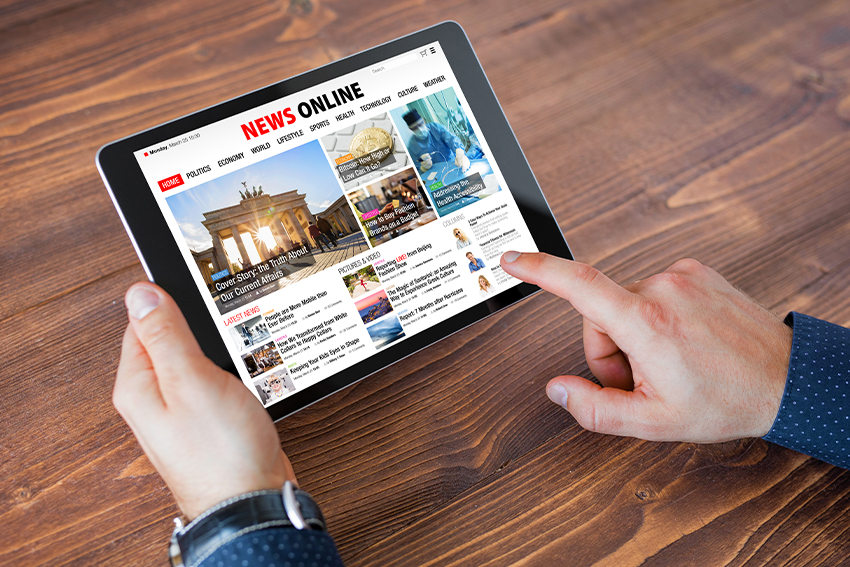The Effect of Social Network en route We Take In News Online
Social media has essentially transformed news intake. It gives instant accessibility to information, often overshadowing traditional media outlets. Nevertheless, this rapid dissemination comes with challenges. Customers deal with the threat of encountering misinformation and becoming entraped in resemble chambers. The formulas driving individualized web content can obscure varied perspectives. As these characteristics develop, recognizing their implications ends up being vital for informed interaction in public discussion. What approaches might assist browse this complicated landscape?
The Evolution of News Usage in the Digital Age
As innovation progressed, the method people consumed news transformed significantly in the digital age (stnews.live). Typical papers and relayed media started to decrease as the web became a key resource of info. Online platforms supplied instantaneous accessibility to news posts, video clips, and podcasts, permitting users to stay educated at any moment. The benefit of smart phones additionally increased this change, making it possible for customers to obtain updates on the go
Additionally, the rise of news collectors and web sites helped with the consumption of varied perspectives, equipping individuals to tailor their news consumption based on individual interests. This advancement additionally prompted news organizations to adapt their techniques, concentrating on digital material and engaging visitors via multimedia layouts. Therefore, the traditional barriers of time and space in news shipment decreased, resulting in a more prompt and personalized news experience for audiences worldwide.
The Function of Social Network Platforms in News Distribution
Social media platforms have transformed news circulation by offering immediate accessibility to details. Their algorithm-driven web content curation frequently focuses on involvement over precision, leading to substantial trustworthiness obstacles (stnews.live). As individuals browse this landscape, the implications for news consumption and public discourse become progressively complicated
Instantaneous News Gain Access To
Although traditional news electrical outlets have actually long been the primary source of information, the surge of social media sites platforms has actually considerably changed just how news is accessed and consumed. Immediate news access has actually become a trademark of the electronic age, enabling users to get updates in real time. Systems such as Twitter, Facebook, and Instagram allow news to spread out quickly, usually surpassing standard media in speed and reach. Users can share stories, comment on occasions, and involve with reporters, creating a vibrant interaction in between the target market and news web content. This immediacy cultivates a society of urgency, triggering individuals to seek information promptly. Subsequently, the assumption for timely news has reshaped journalistic practices, compelling news organizations to adjust their techniques to satisfy the demands of a busy electronic setting.
Algorithm-Driven Content
While individuals proactively engage with web content on social media sites, the formulas that regulate these systems play a pivotal duty in establishing which news tales get exposure. These algorithms analyze individual behavior, preferences, and involvement metrics to curate tailored news feeds. Consequently, certain tales might be intensified while others continue to be odd, often focusing on thrilling or trending topics over substantive reporting. This discerning direct exposure shapes customers' understandings of current events and influences public discussion. The dependence on algorithm-driven web content can create echo chambers, where users are mostly revealed to viewpoints that align with their very own ideas. As a result, the characteristics of news distribution on social media platforms greatly impact exactly how individuals eat and translate information in the digital age.

Reliability Obstacles
As individuals progressively turn to social networks for news, the credibility of information experienced on these platforms ends up being a pressing problem. The decentralized nature of social media allows anyone to release material, usually blurring the lines in between reliable journalism and false information. Algorithms focus on interaction over accuracy, causing the extensive circulation of sensational or deceptive stories. This atmosphere positions significant obstacles for users trying to recognize credible sources. Social network platforms, while striving to battle false information through fact-checking and web content small amounts, run the gauntlet for disparities and biases in their methods. Ultimately, the obligation lies with users to seriously evaluate the news they take in, as the fast spread of information frequently outmatches confirmation initiatives by platforms.
The Rise of Citizen Journalism and User-Generated Web Content
The surge of person journalism has encouraged daily people to share news and viewpoints, often supplying understandings that traditional media may ignore. Nonetheless, this shift likewise provides significant difficulties, particularly the spread of misinformation that can develop from unverified content. As user-generated content becomes extra common, the equilibrium between genuine voices and accuracy in reporting remains an important problem.
Encouraging Daily Voices

Obstacles of False information
While the rise of person journalism has actually opened opportunities for diverse voices in the media landscape, it has actually likewise introduced considerable obstacles associated with false information. The convenience of sharing information with social media systems permits individuals to share news swiftly, but this fast spread typically comes with the expense of precision. User-generated web content regularly lacks the strenuous fact-checking and editorial oversight that standard journalism provides. Sensationalized or incorrect narratives can gain grip, misleading audiences and forming public perception. The blending of viewpoint and truth within social media complicates the difference between reputable details and misinformation. Because of this, consumers have to navigate a significantly complicated media setting, requiring important assuming abilities to determine trustworthy news sources amidst the sound

False information and Its Ramifications for Public Discourse
As social media platforms increasingly control the landscape of info circulation, the spreading of false information poses considerable obstacles for public discourse. False information, typically designed to mislead or provoke psychological feedbacks, can misshape assumptions of reality and threaten depend on in reputable sources. This phenomenon brings about polarized viewpoints, as individuals gravitate towards resemble chambers that enhance their beliefs, further setting departments within culture.
The implications for public discourse are extensive. When residents count reference on incorrect information, significant discussion diminishes, and the democratic process suffers. Misinformation can provoke worry and confusion, impacting public health, security, and political stability. Because of this, promoting media proficiency ends up being essential, equipping people to critically evaluate details and recognize truth from fiction. Dealing with the obstacles positioned by misinformation is important for protecting the integrity of public discourse and making sure a well-informed population with the ability of involving in constructive discussions.
The Influence of Algorithms on News Exposure
Offered the main duty of formulas in determining material presence, their impact on news intake is extensive. These formulas, made use of by social media sites platforms, focus on specific sorts of web content based on individual involvement and preferences. Because of this, news write-ups that line up with preferred patterns or target market passions are more probable to be presented plainly, imp source while less sensational tales may be ignored. This creates an atmosphere where customers are revealed mostly to information that reinforces their point of views, potentially causing echo chambers.
In addition, the constant evolution of formulas suggests that wire service need to adjust their approaches to line up with these changing criteria, often focusing on clickbait or emotionally billed headings. Subsequently, the integrity of news reporting can be endangered, as crucial stories may not get the visibility they are worthy of. The algorithmic shaping of news presence consequently plays a vital role in affecting public perception and understanding of current events.
The Shift Toward Visual Narration in News Media
Progressively, news media is accepting visual storytelling as an effective device to engage target markets. This method leverages images, videos, infographics, and interactive aspects to communicate details better than traditional text-based layouts. As attention extends shorten, visuals supply a fast, impactful way to interact complicated stories and grab audiences' passion.
Systems like Instagram and TikTok have more accelerated this trend, engaging wire service to adapt their web content methods to fit these visually-driven atmospheres. By integrating compelling visuals, news electrical outlets can enhance emotional connections and foster greater understanding of topical issues.
Aesthetic narration permits for even more diverse narratives, showcasing multiple perspectives with vibrant presentations. As target markets increasingly eat news via mobile tools, the shift towards visuals not only accommodates individual choices but likewise helps to break down obstacles to info access. Eventually, this development mirrors a more comprehensive transformation in how news is created and eaten in the electronic age.
Future Trends: Navigating the Transforming Landscape of News Consumption
While the electronic landscape remains to advance, news usage is poised for substantial change driven by emerging innovations and transforming audience habits. As fabricated intelligence and artificial intelligence advancement, customized news feeds will become more prevalent, allowing individuals to obtain content tailored to their passions. This customization might lead to better engagement yet likewise raise issues concerning resemble chambers and misinformation.
Furthermore, the rise of voice-activated devices and smart speakers will certainly influence exactly how news is provided, changing the focus from aesthetic to acoustic formats. This fad might motivate news organizations to take on more concise and engaging audio web content.

Frequently Asked Concerns
How Do Social Media Site Interactions Affect News Integrity?
Social media interactions can significantly affect assumptions of news integrity. Engagement metrics, such as likes and shares, usually form target market count on, with popular blog posts getting regarded authenticity, despite the accuracy or integrity of the details presented.
What Function Do Influencers Play in Shaping News Narratives?
Influencers significantly form news narratives by leveraging their platforms to enhance specific tales, usually customizing content to their audience. This can result in prejudiced point of views, impacting public understanding and focusing on sensationalism over factual reporting.
How Can Users Identify Reliable News Resources on Social Media Site?
Customers can identify trustworthy news sources on social media sites by checking the source's reliability, validating realities with numerous electrical outlets, assessing the professionalism and trust of the web content, and acknowledging prospective prejudices in reporting to guarantee precise info.
What Effect Does Social Media Carry Typical Journalism Jobs?
Social media considerably influences typical journalism tasks by altering revenue versions, decreasing demand for print media, and cultivating competition from citizen journalists. As a result, several professionals encounter job insecurity and have to adapt to quickly altering media landscapes.
Exactly How Do Different Demographics Consume News on Social Media Site?
Various demographics exhibit diverse choices for news usage on social media sites. More youthful audiences prefer systems like TikTok and Instagram for fast updates, while older people have a tendency to favor Twitter and facebook for a lot more extensive discussions and articles.